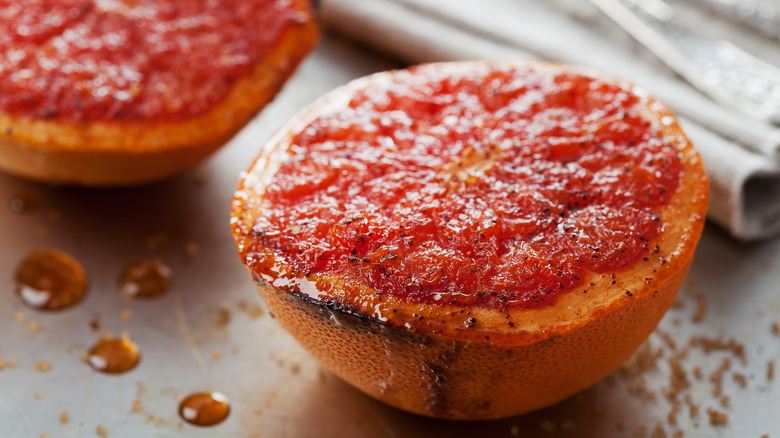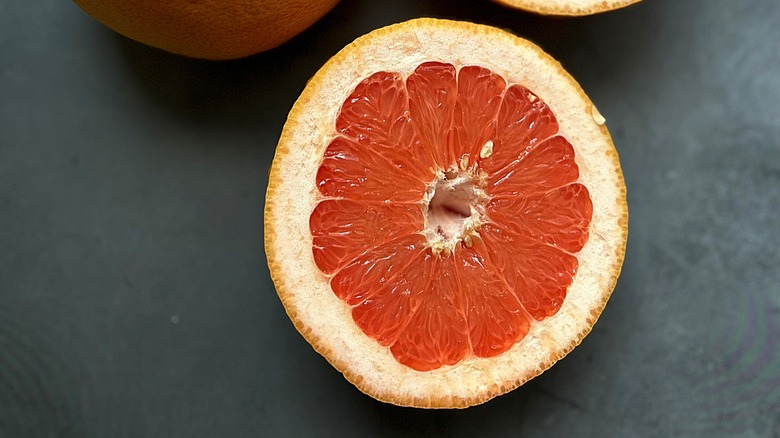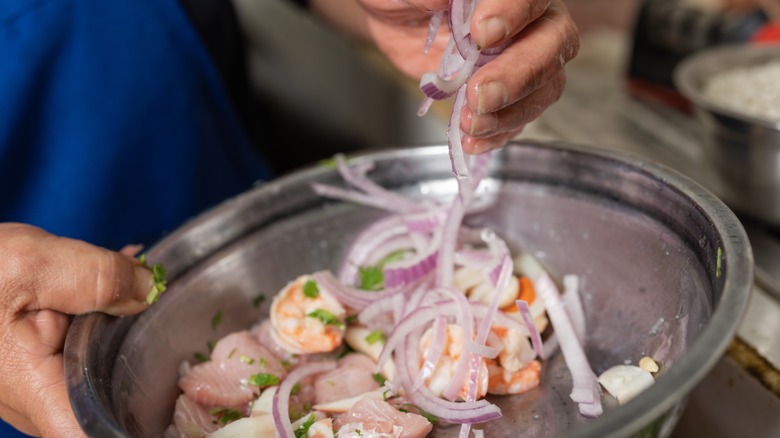Broiled Grapefruit Is The Deliciously Tart Dessert You Didn't Know You Needed
Grapefruit is well-established as a nutritious and occasionally lip-puckeringly sour way to start the day, as well as one of the more common elements in a citrussy fruit salad. However, if you've only ever tried grapefruit cold and uncooked, you may have been sleeping on a new world of citrus flavor: Broiled grapefruit.
Just as you can easily toast sesame seeds and spices to increase their flavor, broiling grapefruit enhances its taste, creating caramel and smoky notes that add complexity. Simply broil your prepared grapefruit slices until you see some black charring begin to appear on the cut surface of your grapefruit halves. Not only does this light charring create a pleasing smoky flavor, but it also adds a more dramatic look that will enhance the appearance of your final plate.
Grapefruit is usually broiled with sugar on top and served for breakfast, or as a dessert with some additional components such as candied blood orange slices or a dollop of whipped vanilla cream. However, as grapefruit naturally contains sugars, it will still experience some charring even without added sugar. So, if you're using broiled grapefruit as an element in a savory dish or prefer a less sweet grapefruit, you can always leave off the sugar.
A simple guide to broiling grapefruit
Broiling grapefruit is pretty simple, but some useful tips will help you get the best results. First, reduce the risk of your grapefruit halves taking an unexpected tumble by cutting a flat base on each half. This will keep them from wobbling about on the baking tray. Then, you should remove the seeds, as they add bitterness when cooked, and release the segments. Segmenting makes the grapefruit easier to eat and reduces the amount of overly bitter white pith that gets scooped up in each spoonful. When releasing the segments, be careful not to damage too much of the grapefruit, as burst citrus kernels release grapefruit juice, and too much of this will allow any added sugar to dissolve and slow the charring and caramelization. If you can get your hands on a grapefruit knife (one with serrated twin blades), this will make separating grapefruit segments even easier.
When it comes to the broiling, a few teaspoons of brown sugar is generally considered enough to top each side. Brown sugar on its own is enough to balance the grapefruit's tart acidity, but you may want to elevate your dish by mixing the sugar with a little cinnamon or cardamom before sprinkling it over your grapefruit. You can also top your grapefruit halves with butter before broiling for added richness.
Other inventive uses for grapefruit
Grapefruit can add aroma, acidity, color, and balance to a range of dishes. Whether broiled or served fresh, it's a welcome citrus component in salads such as radicchio, spinach, and grapefruit salad, but grapefruit's acidity also makes it an alternative to lemon or lime in ceviche. That acidity also helps it play a starring role in several cocktails, from a grapefruit sour to a citrus margarita. However, the most iconic alcoholic drink featuring grapefruit is surely the paloma cocktail.
A broiled grapefruit can add particular charm to a dessert. Serving a grapefruit half with a lightly charred and caramelized surface is enough in itself, but you can also top it off with any dessert ingredients you fancy, such as meringue, berries, or even a little liquor. Grapefruit also works especially well in a sorbet. Keep things simple and make pure grapefruit sorbet, or elevate it to a showstopper by adding champagne for a pink grapefruit champagne sorbet. Adding just a slice of broiled grapefruit to a dish like this could work wonders.


